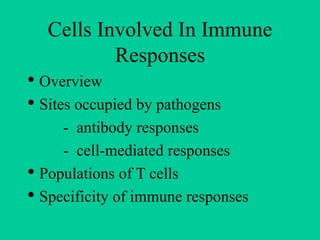
immune response to pathogen.pdf
- 1. Cells Involved In Immune Responses • Overview • Sites occupied by pathogens - antibody responses - cell-mediated responses • Populations of T cells • Specificity of immune responses
- 2. Cells Involved In Immune Responses (continued) • Diversity of receptor specificity • Classes of major histocompatibilty complex (MHC) molecules • Cells of the immune system and origin • Lymphocyte recirculation • Leukocyte migration and localization
- 3. Overview
- 4. Sites Occupied By Pathogens • Extracellular - site of most bacteria - elicits antibody (humoral) response • Intracellular - site of viruses and some bacteria - elicits cell-mediated response
- 5. Types of Antibody Effectiveness • Neutralization: Ab “neutralizes” toxins, binds to attachment molecules • Opsonization: Ab binds to pathogen surface molecules • Complement activation: occurs on antibody bound to pathogens
- 6. Neutralization Bacterial toxins Host cell Toxin receptors Neutralization by antibody Phagocytosis of antibody-antigen complex by macrophage Fc receptor Forming phagosome
- 7. Opsonization Macrophage Extracellular bacteria Opsonization Ingestion by macrophage Digestion in lysosome
- 8. Complement Activation C2 C4 C1 Digestion in lysosome Bacteria in plasma C1 C4 C2 Complement activation Lysis and ingestion
- 9. Common Fate of Pathogen or Toxin After Neutralization, Opsonization, or Complement Activation • Fc or complement receptors on phagocytic cells bind pathogen/toxin complexed with antibody • Endocytosed complex fuses with lysosomes containing acid hydrolases • Complex digested by lysosomal hydrolases
- 10. Fate of Antibody-Toxin or Antibody-Pathogen Complexes Lysosome Phagosome fuses with lysosome, antigen–antibody complex is digested by lysosomal hydrolases Phagosome
- 11. Cell-Mediated Responses Two intracellular compartments: • Cytosolic: cytosol and nucleus connected via nuclear pores - site of viruses and some bacteria • Vesicular: membrane-bound entities (endoplasmic reticulum, endosomes, lysosomes, Golgi apparatus) - site of some bacteria, some parasites
- 12. Location of Pathogen Determines Which T Cell Population Responds • Cytosolic: cytotoxic T cells (Tc) that express CD8 • Vesicular: subpopulation of helper T cells (Th1) that express CD4 • Extracellular: subpopulation of helper T cells (Th2) that express CD4
- 13. Cytotoxic (Tc) T Cells Virus infects cell A B C Cell expresses viral antigens Cytotoxic T cell Infected cell is killed by cytotoxic T cell by activation of nucleases that cleave host and viral DNA
- 14. Helper (Th1) T Cells Macrophage Macrophage Th1 cell lysosome mycobacteria antigen Infected macrophage Activated infected macrophage
- 15. Specificity of Immune Responses Resides in Receptors •T cell receptor (TCR) recognizes peptide associated with major histocompatibility complex (MHC) and is univalent. T cell •B cell receptor (surface immunoglobulin) recognizes antigen and is bivalent B cell
- 16. Diversity of Receptor Specificity (Repertoire) Historically two different hypotheses to explain diversity: • Instructional (template) • Clonal selection • Instructional hypothesis, although simpler, does not explain how host distinguishes self from non-self antigens
- 17. Four Basic Principles of Clonal Selection 1. Each lymphocyte bears a single type of receptor of a unique specificity. 2. Interaction between a foreign molecule and a lymphocyte receptor capable of binding that molecule with high affinity leads to lymphocyte activation.
- 18. Clonal Selection (continued) 3. Differentiated effector cells derived from an activated lymphocyte will bear receptors of identical specificity to those of parental cell from which the lymphocyte was derived. 4. Lymphocytes bearing receptors for self molecules are deleted at an early stage in lymphoid cell development.
- 19. Class I MHC Molecules • expressed on surface of all nucleated cells • recognized by TCR of cytotoxic T cells • CD8 binds to class I MHC-peptide complex • source of peptide is cytosolic compartment
- 20. Class II MHC Molecules • expressed on surface of some nucleated cells, mainly antigen presenting cells (APC) • recognized by TCR of helper T cells • CD4 binds to class II MHC-peptide complex • source of peptide is vesicular compartment
- 21. Cells Expressing Class I and Class II MHC Class I MHC Class II MHC All nucleated cells express class I MHC Cells expressing class II MHC also express class I MHC
- 22. Non-specific and Specific Immunity: Contrasts Non-specific (natural, native, innate) • system in place prior to exposure to antigen • lacks discrimination among antigens • can be enhanced after exposure to antigen through effects of cytokines
- 23. Non-specific and Specific Immunity: Contrasts Specific (acquired, adaptive) immunity • is induced and enhanced by antigen • shows fine discrimination • has memory The non-specific and specific immune systems interact with each other!
- 24. Cells of the Immune System • All derive from the bone marrow • Two main lineages derive from the bone marrow hematopoietic stem cells: 1. Lymphoid lineage T cells, B cells, Natural Killer (NK) cells 2. Myeloid lineage Monocytes, Macrophages, Dendritic cells, Megakaryocytes, Granulocytes
- 25. Hematopoiesis NK Myeloid progenitor Lymphoid progenitor Tc cell TH cell Hematopoietic Stem cell B cell Granulocyte Platelets Megakaryocyte Macrophage Monocyte Dendritic cell AFC Plasma cell Mast cell
- 26. Lymphocyte Recirculation • Secondary lymphoid tissues (lymph nodes, spleen) main sites where lymphocytes encounter antigen • Frequency of lymphocytes having a receptor specific for a given antigen is low • Recirculation of lymphocytes through lymphoid tissues optimizes productive encounters with antigen to initiate response
- 27. Lymphocyte Recirculation Naïve lymphocytes enter lymph nodes from the blood circulation Lymphocytes return to blood via the thoracic duct Antigens from infected area go to lymph nodes via the lymphatic system
- 28. Leukocyte Migration and Localization • Bone marrow and thymus (primary lymphoid tissues) produce B cells and T cells, respectively • B cells and T cells recirculate through spleen and lymph nodes (secondary lymphoid tissues) • Antigen presenting cells (APC) pick up antigen and migrate to secondary lymphoid tissues and interact with T cells and B cells
- 29. Leukocyte Migration and Localization T cell T cell T cell B cell B cell B cell APC T cell B cell Naive lymphocytes Bone marrow Thymus Spleen and lymph nodes Tissues Primed lymphocytes Dendritic cell Macrophage
